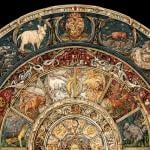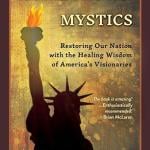A Trinity-Shaped Life: A Meditation for Trinity Sunday
Trinity Sunday, May 30, 2010
I wonder if, on Trinity Sunday, many people feel like the sermon is answering a question they aren’t asking. (What does the Trinity have to do with my daily life?) And many preachers may think to themselves, “Here is another occasion when my job is to try to convince people that an abstract concept they never give much thought to is foundational to their lives.”
The Trinity is “the centerpiece of Christian theology and sometimes considered the most subtle and abstruse of all doctrines.” (Eugene H. Peterson, Christ Plays in Ten Thousand Places: A Conversation in Spiritual Theology, 45)
It’s the subtle and abstruse part that is the problem. All that detail about homoousious and hypostases and who proceeded from whom. The preacher can take a couple of different tacks. She can exhaustively explain the history and nuances of the doctrine of the Trinity, going into details about person and substance and procession until listeners are blurry eyed and eager for escape. Or she can opt for the overly simplistic approach and say “It’s a mystery. Just remember the number three. That’s all you really need to know for the test.”
A better approach is to paint the broad brushstrokes of the doctrine and ask, what’s at stake? So what? What’s at stake in claiming that there are three persons and one essence, not just God being called different things at different times? What’s at stake in claiming that there is one God, not three? What’s at stake in insisting that Jesus is of one substance with the Father and not just a really good guy who got a promotion?
Another way of asking this is to say: What kind of life does the Trinity shape? To jumpstart some homiletical reflection, I’m going to start with one theologian’s response to that question. I’ll follow that with what I call a “theological tune-up,” on the Trinity, a reminder of some details we once knew and probably still sort of remember… I’ll follow that with a few reflections on the lectionary texts for Trinity Sunday.
What kind of life does the Trinity shape?
Personal and Participatory
Eugene Peterson, in his book Christ Plays in Ten Thousand Places: A Conversation in Spiritual Theology (William B. Eerdmans Publishing Co, 2005) reminds us that “our Greek theological ancestors used the term perichoresis to describe the Trinity.” Perichoresis is the Greek word for dance. Peterson asks us to imagine a folk dance with three partners in each set. The music starts up and the partners holding hands begin moving in a circle. On signal from the caller, they release hands, change partners, and weave in and out, swinging first one and then another. The tempo increases, the partners move more swiftly with and between and among one another, swinging and twirling, embracing and releasing, holding on and letting go. There is no confusion, every movement is cleanly coordinated in precise rhythms, as each person maintains his or her own identity. To the onlooker the movements are so swift it is impossible at times to distinguish one person from another; the steps are so intricate that it is difficult to anticipate the actual configurations as they appear: Perichoresis (peri=around; choresis=dance)(45). Peterson concludes that this metaphor for the Trinity, a subtle and abstruse doctrine, can be observed by anyone in an American neighborhood barn dance or an Irish ceilidh.
“We are baptized in the name of the Trinity. Our Christian lives are an immersion in the triune God, God the Father, God the Son, and God the Holy Spirit. We are shaped by this triune life. “We are now participants in the company of the God who creates heaven and earth, who enters history and establishes salvation as its definitive action and who forms a community to worship and give witness to his words and work” (303).
What kind of life does the Trinity shape? Lives that are a personal response to a personal God that results in participation in community. It does make a difference that God is three persons and one substance. It means we can only know God by personal response that is a participation in the activity of our Triune God in community.
A personal response to a personal God: “God is nothing if not personal” (45) and can only be known by personal response. We cannot know God through impersonal abstractions or in solitary isolation (46). “The only way God reveals himself (sic) is personally. Never impersonally as a force or an influence, never abstractly as an idea or truth or principle” (304).
A participation in the Triune community of God: We cannot live as spectators of the dance of the Trinity.” A hand reaches out to pull us into the Trinitarian actions of holy creation, holy salvation and holy community…” (46) “There are no nonparticipants in a Trinity-revealed life… God is never a nonparticipant in what he does. He does not separate himself from his community by ranks of angel-secretaries through whom we have to arrange an audience.” (305)
We began by wondering if there was any relevance to our everyday lives in this abstract doctrine called the Trinity. It turns out the Trinity is a personal, participatory reality that threatens to bring God a little too close for comfort.
Theological Tune-Up
The belief in the Trinity is the theological cornerstone of Roman Catholicism, Eastern Orthodoxy and traditions that have arisen from the Protestant Reformation. Among those rejecting the notion of the Trinity are Jehovah’s Witnesses, Mormons and Unitarians. The doctrine of the Trinity was articulated in response to the beliefs of Arius in the 4th century who insisted that the Son was a created being and did not share the full divinity of the Father. Worked out at the Council of Nicea in 325, what has come to be known as the doctrine of the Trinity affirmed that God is three persons (hypostases) but one substance (or essence) (homoousion). God does not simply take different forms. Nor are there 3 Gods. There is one God in three persons. They are equal in power, eternity and wisdom.
In describing Jesus, the Nicene Creed says, “And we believe in one Lord Jesus Christ, the Son of God, begotten of the Father (the only-begotten; that is, of the essence of the Father, God of God), Light of Light, very God of very God, begotten, not made, being of one substance with the Father.” In the late sixth century (587), the Latin-speaking churches of Western Europe added the words “and the Son” (Filioque) to the description of the procession of the Holy Spirit. Eastern Churches have historically disagreed with that addition.
Some notes from the classic work A Manual of Christian Doctrine, Louis Berkhof, 1933. God is one in His essential being, but in this one being there are three persons, called, Father, Son and Holy Spirit. These three persons are modes or forms in which the divine essence exists. The real mystery of the Trinity consists in this: that the three persons are one in their essential being. The divine essence is not divided into thirds. It is wholly present in each of the three persons. The persons are not subordinate to one another in their essential being.
The doctrine of the Trinity is not explicitly articulated in Scripture. But hints of all three occur in the O.T. For example, in Genesis 1:26 and 11:7 God speaks of himself in the plural. The angel of Jehovah is represented as a divine person (Gen 16:7-13; 18:1-21; 19:1-22) and the Spirit is spoken of as a distinct person in Isaiah 48:16 and 63:10. See Isaiah 42:16, 61:1, and 63:9, 10 for passages in which 3 persons are indicated. In the New Testament there are several passages in which the three person are expressly mentioned, as in connection with the baptism of Jesus (Luke 3:21-22), in the farewell discourses of Jesus (John 14-16), in the great commission (Matt 28:19), in the apostolic blessing (2 Cor 13:13), and in such passages as Luke 1:35, 1 Cor 12:4-6 and 1 Peter 1:2. (A Manual of Christian Doctrine, Louis Berkhof , 76-77)
The Distinctive Property of the Father
The Father generates the Son from all eternity.
The Distinctive Properties of the Son
1. His eternal generation; By means of this generation the Father does not call the essential nature of the Son into being, but becomes the cause of the personal subsistence of the Son, a second mode of existence, within the divine being. This generation of the Son should not be regarded as an act completed in the past, but as a necessary and eternal act of the Father. It is timeless, always continuing, and yet ever complete.
2. His divinity
3. His works – All things are out of the Father, but they are through the Son. The Father is the final cause of both creation and redemption. The Son is the mediating cause. All things are created and maintained through the Son. He is the light which lighteth every man (sic) coming into the world. The work of redemption is carried out by the Son in His incarnation, sufferings and death (Eph 1:3-14) (Berkhof, 79-80)
The Holy Spirit
The Holy Spirit is not just the influence of God or some abstract principle. The Spirit is designated as a person with personal attributes such as intelligence (John 14:26; 15:26; Rom 8:16), affections (Isa 63:10, Eph 4:30), and will (Acts 16:7; 1 Cor 12:11). The Spirit speaks, searches, testifies, commands, reveals, strives, and intercedes. (Gen 1:2; 6:3; Luke 12:12; Jn 14:26; 15:26; 16:8; Acts 8:29; 13:2; Ro 8:11; 1 Cor 2:10, 11).
The Spirit’s special task is to bring the work of God to completion both in creation and redemption. The Spirit inspires and qualifies people for special tasks in the O.T. (Ex 28:3; 31:2, 3, 6; 35:35; 1 Sam 11:6; 16:13, 14. In the N.T. the Spirit prepares and qualifies Christ for his redemptive work (Luke 1:35; 3:22). The Spirit inspires Scripture (1 Cor 2:13, 2 Peter 1:21), forms and augments the Church, and dwells in it as the principle of a new life (Eph 1:22, 23; 2:22; 1 Cor 3:16; 12:4ff). The Spirit teaches and guides the Church, leading it in all truth (John 14:26; 15:26; 16:13, 14; Acts 5:32; Heb 10:15; 1 John 2:27)… (Berkhof, 82)
The Father’s role is to create the world and generate the Son from all eternity (which is a continuous process) The Generator
The Son’s role is to be the one through whom all things come into being and to bring about the work of redemption through his incarnation, sufferings and death. The Redeemer
The Holy Spirit’s role is to inspire men and women for special tasks, to equip Jesus for his task, to inspire scripture, to unify and direct the church. The Spirit’s role is to bring the work of God to completion in creation and redemption. The Completer.
Writes ethicist Gabriel Fackre “The unique source of the unique Christian story is the one tri-personal God. Father, Son and Holy Spirit are Persons that indwell one another in such a manner that “They” are, in fact, a “Thou.” While other religions may profess that God is loving, the Scriptures of this faith declare God is Love, the triune Life Together. (Christology in Context: The Christian Story: A Pastoral Systematics, Grand Rapids, Michigan: Wm. B. Eerdmans Publishing Co., 2006, 241).
Connection with Lectionary Texts for May 30, 2010
Romans 5:1-5 The “grace cycle,” in which suffering leads to endurance, which leads to character, which leads to hope because God’s love has been poured into our hearts by the Holy Spirit which has been given to us.
John 16:12-15 Jesus promises the “Spirit of truth” who will lead us into all truth.
Proverbs 8:1-4, 22-31 Woman Wisdom, a female metaphor for an aspect of God’s character, recounts her participation with God in Creation.
The theme of the Triune God as calling for a personal, participatory response certainly gleams through these texts in which, in one place and another, all three persons of the Trinity join in the dance.
What follows is a brief reflection on Woman Wisdom from Proverbs 8. She might be said to be an aspect of the character and work of all three persons of the Trinity. She deserves a whole sermon series of her own, but this short treatment will have to suffice for now.
Woman Wisdom, as a personification of God’s guidance of the community, arose in the tumultuous postexilic period when traditionally male bastions of authority had crumbled (king and court, priest and temple). The authority of parents, including mothers, in the home was more important than ever. The figure of personified Wisdom remained an important symbol as Judaism developed in the Hellenistic world, focusing on her Greek name, Sophia. Both Sirach and the Wisdom of Solomon developed her portrait as acting at God’s command, ordering the cosmos and revealing God to Israel. Philo of Alexandria used Wisdom and Logos interchangeable as symbols of the working of God in the world, but insisting that the male Logos was superior to the female Wisdom, thus preparing the way for the substitution of Logos for Wisdom we find in the Prologue to the Gospel of John.
Paul, in 1 Corinthians, attributes to Christ the cosmological role in creation that had been held by Wisdom (1 Cor 8:6). He proclaims Christ crucified as “the power of God and the wisdom (Sophia) of God” (1 Cor 1:24) Most early church writers identified Wisdom with the Logos, and with the divine in Jesus Christ. Others, like Irenaeus of Lyons, identified her with the third person of the Trinity. The affirmation of Sophia of Proverbs 8:22-31 as fully divine and consubstantial with the Father was crucial for Athanasius’ claim that Jesus was begotten by God and not a creature who had a beginning in time. (Alyce M. McKenzie, Preaching Proverbs: Wisdom for the Pulpit, Westminster JohnKnox Press, 1996, 71-72)
In Proverbs 8, Wisdom’s teaching are said to yield reward more precious than worldly wealth (8:19-21). In verse 22 Woman Wisdom weights her words with the authority of her relationship with Yahweh. She asserts that she was created before anything else and points to this as a mark of the highest honor. She was with Yahweh, beside him, during the creation.
The word translated “master worker” (amon) may refer to a “crafts (wo)man” assisting in the work of creation or it could connote a child playing. Woman Wisdom is a heavenly being who wishes to form a relationship with disciples modeled on her relationship with Yahweh. She was daily his delight and she rejoices (plays) before God and the created world. She delights in the human race. She brings these joyous verses to a close by affirming her role as the one who summons human beings to blessedness and happiness (8:32-34) (Alyce M. McKenzie, Preaching Biblical Wisdom in a Self Help Society, Abingdon Press, 2004, 114)
Here we can’t help but think to ourselves: She reminds me of someone….
It is no coincidence that Jesus himself may well have viewed himself as an envoy of Wisdom (Luke 7:33-35; Matt 11:18-19).
In Proverbs, Woman Wisdom actively seeks out followers, standing at the city gates. She speaks to everyone, not just the simple. Her teachings are trustworthy and lead to great benefit. This trustworthiness is grounded in her relationship with Yahweh. She loves God, God’s creation and human beings. This is no pale, static love, but an active delight, a playful, sportive love. Wisdom seeks us out because she loves us. And she seeks us out because she loves God. There is some mysterious delight to the life of Wisdom that involves the love of God, humankind and Wisdom in a kind of circle dance. (115)
by Alyce M. McKenzie, Professor of Homiletics, Perkins School of Theology, Dallas, TX. Visit Alyce McKenzie’s Website












